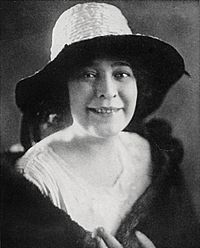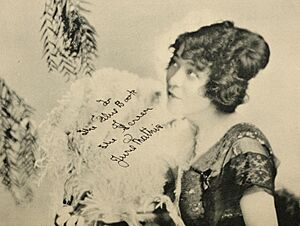June Mathis facts for kids
Quick facts for kids
June Mathis
|
|
|---|---|

June Mathis, c.1920
|
|
| Born |
June Beulah Hughes
January 30, 1887 Leadville, Colorado, U.S.
|
| Died | July 26, 1927 (aged 40) New York City, U.S.
|
| Resting place | Hollywood Forever Cemetery |
| Years active | 1916–1927 |
| Known for | Discovering Rudolph Valentino |
| Spouse(s) |
Sylvano Balboni
(m. 1924) |
June Mathis (born June Beulah Hughes, January 30, 1887 – July 26, 1927) was an amazing American screenwriter. She made history as the first female executive at Metro/MGM, a huge movie studio. By age 35, she was the highest-paid executive in all of Hollywood. In 1926, people thought she was the third most powerful woman in Hollywood. June Mathis is famous for finding the movie star Rudolph Valentino. She also wrote many popular films, like The Four Horsemen of the Apocalypse (1921) and Blood and Sand (1922).
Contents
June Mathis: Early Life and Dreams
June Mathis was born June Beulah Hughes in Leadville, Colorado. She was the only child of Virginia Ruth and Dr. Philip Hughes. When she was seven, her parents divorced. Her mother then married William D. Mathis, who had three children. June later used his last name as her stage name.
As a child, June was often sick. She believed she healed herself by sheer willpower. She thought everything was about your mind and energy. She said, "If you are vibrating in the right place, you will inevitably come in contact with the others who can help you."
June went to school in Salt Lake City and San Francisco. In San Francisco, she started performing on stage. She danced and did imitations in vaudeville shows. At 12, she joined a traveling theater group. By 17, she was playing young, innocent characters. She toured for four seasons with Julian Eltinge, a famous male performer who dressed as a woman. June performed in the popular show The Fascinating Widow. She continued acting for 13 years to support her mother.
June Mathis: A Career in Movies
Becoming a Screenwriter
June Mathis was determined to become a screenwriter. She moved to New York City with her mother. There, she studied writing and watched many movies. She entered a screenwriting contest. Even though she didn't win, her script was so good that she received job offers.
Her first movie script, House of Tears, was filmed in 1915. This led to a contract in 1918 with Metro studios. Metro later joined with Goldwyn and Louis B. Mayer Pictures to become MGM. June was one of the first screenwriters to add detailed stage directions and settings to her scripts. She believed this made movies more artistic. Many standard screenwriting styles today came from her ideas. June said her success came from focusing on the story's main idea.
By 1919, June and her mother moved to Hollywood. After just one year, she became the head of Metro's scenario department. This meant she was in charge of all the movie scripts. She was one of the first women to lead any film department. She was also the only female executive at Metro.
The Four Horsemen of the Apocalypse
In 1921, Richard A. Rowland, the head of Metro, bought the rights to a book called The Four Horsemen of the Apocalypse. He paid $20,000 and 10% of the movie's earnings. Other studios thought this book was too hard to turn into a movie. But Rowland gave it to June Mathis to adapt. He was so impressed with her script that he asked her to help choose the director and star.
June had seen a young actor named Rudolph Valentino in a small role. She strongly suggested he play the main part. Studio bosses didn't want to hire an unknown actor for such a big role. But June insisted. Even with all her other achievements, discovering Valentino became her most famous act. She also insisted that Rex Ingram be hired as the director.
The Four Horsemen of the Apocalypse was one of the first movies with an anti-war message. June also included scenes that showed different ways of living. For example, it had a scene where German officers came down stairs dressed in women's clothes. June told the Los Angeles Times that this scene had a deeper meaning for those who understood life.
June Mathis and Rudolph Valentino

The Four Horsemen of the Apocalypse was a huge success. It earned $4,500,000 in the U.S. alone. This made it one of the most successful silent films ever. It also made Rudolph Valentino a huge star. Even before the movie was released, other studios wanted to hire him. June advised him to stay with Metro for a while to get more good roles.
June and Valentino remained close friends. June, who was older, cared deeply for the talented young actor. Valentino saw June as a mother figure and called her "Little Mother." Actress Nita Naldi said, "She mothered Rudy, and my dear she worshiped him and he worshiped her." Valentino himself said in 1923, "She discovered me, anything I have accomplished I owe to her."
June looked out for Valentino at Metro. She made sure he got the best parts and was well taken care of. But when Valentino became a big star, he wanted more money. He signed with another studio, Famous Players-Lasky (later Paramount Pictures), for a much higher salary.
June also helped Valentino when he had legal trouble. He was arrested for marrying Natacha Rambova before his divorce from Jean Acker was final. This was against the law at the time. Although they were very close, their friendship became difficult during Valentino's marriage to Rambova. When June wrote a script for one of Valentino's favorite projects, the couple didn't like it. June felt insulted and stopped talking to Valentino.
A Powerful Executive
The Los Angeles Times called June Mathis's job at Metro "The Most Responsible Job ever Held by A Woman." She was one of the most powerful women in Hollywood. Some even said she was almost as powerful as Mary Pickford. June had a lot of say in who was cast in movies and who directed them. She was very good at preparing detailed scripts with the director. This helped save money during production and made the stories flow better.
After seven years at Metro, another studio, Famous Players-Lasky, offered her a job. They promised she could keep writing for Valentino. When Valentino moved to Goldwyn Pictures, June moved too. This time, she gained even more control over movie productions.
June Mathis: Later Career and Challenges
Greed and Ben-Hur
June Mathis stayed successful in Hollywood even after being involved in two big movie challenges of the 1920s. One was the film Greed (1924). The director, Erich von Stroheim, made a very long version of the movie, about 10 hours! Studio executives demanded it be cut shorter. MGM, which now owned Goldwyn, gave the film to June Mathis. She was told to cut it even more. Many important parts were removed, which caused confusion in the story.
People still debate if June Mathis personally cut the film. However, her name was in the credits as a writer. So, she was blamed by the director and his fans for "messing with his genius." But June had worked with Stroheim before and liked his ideas. So, it's unlikely she would have ruined his film on purpose.
Another huge project was Ben-Hur (1925). June fought with the studio for months over casting and how to make the movie. It was her idea to film the expensive script in Italy. The movie ended up costing nearly $4 million. There were many problems during filming in Italy, including political issues. When a sea battle was filmed, many extras lied about being able to swim. During the chariot race filming, one stuntman was killed.
MGM took over the production when it merged with Goldwyn. The movie was way over budget and out of control. The studio stopped filming in Italy and moved the production to California. They fired June Mathis, the director, and the main actors. They hired new people to finish the film.
After returning to the U.S., June was hired by First National Pictures. She wrote several successful movies for actress Colleen Moore. June stayed at First National for two years. Then she left and signed with United Artists. She made one movie with her husband for them, The Masked Woman. The Magic Flame (1927) was her last movie and one of her best.
June Mathis: Personal Life
June Mathis was a short woman with wild brown hair. She loved Parisian fashion. She was also one of the first "writer-directors." She helped set the stage for screenwriters to become producers later on. June was a spiritualist and believed in reincarnation. She always wore an opal ring when she wrote, thinking it helped her get ideas.
June had been linked to actors George Walsh and Rex Ingram. But she returned from Italy engaged to an Italian cinematographer named Sylvano Balboni. They married on December 20, 1924, in Riverside, California.
June Mathis: Death and Legacy
After Valentino's marriage ended in 1925, he and June became friends again. They reconnected at the premiere of Son of the Sheik. When Valentino died unexpectedly in August 1926, June offered him a temporary spot in her family crypt. This was a burial place she had bought in Hollywood Memorial Cemetery (now Hollywood Forever Cemetery). However, when June herself died the next year, the arrangement became permanent.
On July 26, 1927, June Mathis was watching a Broadway show called The Squall. She was with her 84-year-old grandmother. June suffered a fatal heart attack. Her last words were reportedly, "Mother, I'm dying!"
Her ashes were brought back to California. Instead of moving Valentino, June's husband, Sylvano Balboni, moved Valentino to the crypt next to hers. He then sold the remaining crypt to Valentino's family and returned to Italy. June Mathis and Rudolph Valentino are still buried side by side today.
Images for kids
See also
 In Spanish: June Mathis para niños
In Spanish: June Mathis para niños





